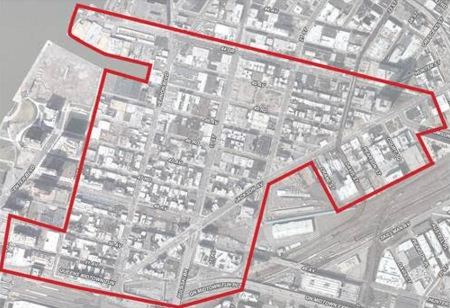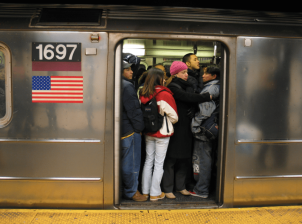Transit Was the Key to Amazon’s Choice of Long Island City
The booming neighborhood is already facing challenges bringing its transportation infrastructure up to speed. Here's what you need to know.

If Amazon is truly bringing one-half of its new headquarters to Long Island City, New York’s city and state officials have their work cut out for them.
It’s not clear year exactly where in the western Queens neighborhood Amazon will put the so-called HQ2. One possible location is the Court Square headquarters of Citigroup on the north side of the neighborhood, which is set to downsize in 2020. Another is on the south side, near the Jackson Avenue-21st Street subway station. Yet another is the as-yet-undeveloped Sunnyside rail yard.
Either way, Long Island City will get at least 25,000 people added to its daily workforce. That means 25,000 more people using its subways, buses, and streets. And that’s on top of new residents already filling the thousands of apartments being built there.
SIDEBAR: FIND OUT MORE ABOUT AMAZON’S OTHER HQ2 SITE IN SUBURBAN WASHINGTON, D.C.
Here’s a rundown of the myriad challenges currently facing the booming neighborhood:
Subways, Buses and the Long Island Rail Road
A high-functioning transit system was one of Amazon’s stated desires when it announced the search for a second headquarters last year. Long Island City is flush with transit options: the 7, G, M, E, N, and W trains — plus no less than 11 local bus routes.
Whether those buses and trains can handle any more riders is another question. The 7 train is notoriously crowded at rush hour, but that should improve once the MTA begins running modern signal technology on the line sometime this year. The G and M trains, meanwhile, have extra capacity, as do reverse-peak 7 trains, Stephen Smith of Market Urbanism noted:
Realistically, I think we can count on the reverse-peak 7 and the G to carry most of the capacity. To the extent that Amazon employees will live in Queens, they're already there (so actually lessening East River crowding), or will live w/in walking or, at worst, biking distance
— Market Urbanism (@MarketUrbanism) November 6, 2018
And buses on Queens Boulevard are frequently caught in car traffic, as Clarence Eckerson Jr. pointed out this week.
The good news is also the bad news: the MTA can test a lot of its Long Island City capacity next year, when the Court Square station is expected to handle a surge in riders displaced by the temporarily shuttered L train.
A recent (conveniently timed) report from the city’s Economic Development Corporation, meanwhile, suggests that the city wants to work with MTA to open a new Long Island Rail Road stop at the Sunnyside Yards. The MTA is also acquiring funding for “station enhancements” at Court Square and Queensboro Plaza, the report said [PDF]. Streetsblog has reached out to the agency for more on those station enhancements.
Another transportation wild card — Mayor de Blasio’s proposed Brooklyn-Queens streetcar — might get a boost, though its cost and timeline have already stretched past the city’s initial projections.
Biking and Walking in Long Island City
The city is about to undertake a nearly $40-million reconstruction of the neighborhood’s streets, which have not been touched in nearly a century. The EDC report released last week announced another $10 million for that effort, though it’s not clear what the city plans to do with it.
Spot improvements at dangerous intersections make up the bulk of that work, as opposed traffic-calming or bike infrastructure improvements [PDF]. Still, there are exciting elements: By the Vernon Boulevard-Jackson Avenue subway station, DOT plans to significantly expand pedestrian space, removing the huge swath of parking that’s there at the moment.
Unfortunately, the bike infrastructure plans fall short: While 11th Street provides the most direct connection between the bike lane on the Pulaski Bridge and points north, the agency wants Vernon Boulevard to serve as the north-south protected bike lane connection. The project does not include any safe east-west bicycle connection.

There’s also concern for pedestrians. On Jackson Avenue, arguably the neighborhood’s most dangerous street for walking, DOT’s plan is limited to adding concrete medians. There’s no plan to calm traffic on the street, where 64 people — including 10 cyclists — have been injured in traffic crashes since 2014, according to Crashmapper. But for cyclists, DOT is merely planning to install sharrows.
By and large, the neighborhood’s streets are designed for moving industrial traffic, trucks in particular. They’re just not conducive to large numbers of people walking and biking,LaGuardia Community College professor and Queens bike advocate Joby Jacob said.
“The streets are really focused on moving cars,” he told Streetsblog. “That means that pedestrians have longer waiting times then they should. It also means that cars whip around wide turning radiuses really quickly.”
Who’s Paying for All This?
All those transportation improvements aren’t going to pay for themselves. Ideally, Amazon will help the city cover its costs, but there’s no guarantee. The city and state have already committed to providing tax subsidies to Amazon, the Times reported yesterday, and there’s no way to know what they are. Those deals are made entirely in secret.
“The fact that public funds can be committed in complete secrecy is really, completely appalling and undemocratic,” said John Kaehny of the good government group Reinvent Albany. “They say, ‘No taxation without representation,’ but these are our tax dollars going to potentially subsidize one of the largest companies in the world.”
By and large, research has shown that government subsidies are a minimal factor in attracting companies like Amazon to cities. NYC’s transit system alone was likely enough to lure Amazon here, Kaehny said — the subsidies are just the “icing on the cake.”
“The public investment that needs to happen is in the subways and buses, and walkability,” Kaehny said. “The things that make Long Island City appealing to Amazon are the [past] investments that New York made to make itself a walkable city.”


